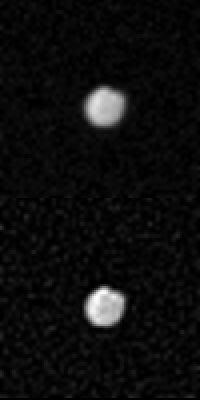
|
Voyager 2 Movie of Saturn’s Moon: Phoebe
- Click the image above for a larger view
 Movie Download Options
Movie Download Options
Caption:
Voyager 2 took this photo sequence of Saturn's outer satellite, Phoebe, on Sept. 4, 1981, from 2.2 million kilometers (1.36 million miles) away. The top image is the normal version and the bottom is an enhanced version to increase resolution. This sequence lasts 23.4 hours and contains 35 images. The early images were taken about 43 minutes apart, while the later ones are about 29 minutes apart. There are two significant gaps in the sequence: images 7 and 8 are separated by 2.3 hours and images 19 and 20 are separated by 2.8 hours.
Because the sunlight is coming from the left, mountains and ridges can best be seen as they reflect the sunlight near the terminator (right side of Phoebe). Other intrinsically bright spots can be seen rotating across the whole disk. In this time-lapse sequence, Phoebe appears to be a lumpy spheroid with possible large mountains sometimes showing on the limb (left side of Phoebe). The photos show that Phoebe is about 220 kilometers (132 miles) in diameter. Its rotation period (length of day) was determined from this set of images to be 9.4 hours (see Thomas, P., et al. , "Phoebe: Voyager 2 Observations," Journal of Geophysical Research , vol. 88, p. 8736, 1 November 1983).
These images were processed by the Multimission Image Processing Laboratory of the Jet Propulsion Laboratory.
Background Info:
The Voyager project is managed for NASA by the Jet Propulsion Laboratory.
Cataloging Keywords:
| Name | Value | Additional Values |
|---|---|---|
| Target | Phoebe | |
| System | Saturn | |
| Target Type | Satellite | Irregular |
| Mission | Voyager | |
| Instrument Host | Cassini Orbiter | Voyager 2 |
| Host Type | Orbiter | Flyby Spacecraft |
| Instrument | Imaging Science Subsystem (ISS) | |
| Detector | ||
| Extra Keywords | Grayscale, Mountain, Movie, Rotation | |
| Acquisition Date | ||
| Release Date | 2000-04-06 | |
| Date in Caption | 1983-11-01 | |
| Image Credit | NASA/JPL | |
| Source | photojournal.jpl.nasa.gov/catalog/PIA02260 | |
| Identifier | PIA02260 | |
